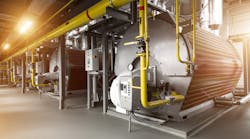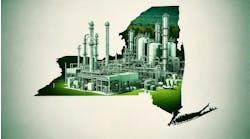Of all my consulting assignments, none has been so strange as “The Case of the Magic Burner.” My client asked me to evaluate this new technology, with the objective of upgrading some boilers.
The vendor claims were interesting, to say the least. The burner requires virtually no excess air, and produces essentially no carbon monoxide or NOx. Furthermore, because of high flame speed, it delivers excellent heat transfer. However, what really caught my attention was the claim that the burner would reduce fuel use in the boilers by 30–40%. The nameplate efficiency of the boilers was over 90% (lower heating value (LHV)), equivalent to about 81% (higher heating value (HHV)). If the burners could reduce the fuel use by even 30%, while still delivering the same amount of useful heat, the energy efficiency would significantly exceed 100%, thus violating the first law of thermodynamics (conservation of energy).
Remarkable claims demand remarkable evidence. I told the vendor CEO that if he could prove his claims, I would personally recommend the burner’s inventor to the Nobel committee.
The efficiency of boilers and furnaces is defined as: efficiency (%) = (useful heat delivered)/(total heat supplied)×100. This is deceptively simple. First, “heat supplied” can be based on either higher heating value, which includes the latent heat of condensation of water vapor in the exhaust gases, or lower heating value, which omits the latent heat. As water condenses, so also do the acid gases (especially SOx) in the exhaust stream. This “acid condensation” is extremely corrosive, and damages most heat transfer surfaces and casings. Consequently, except in specialized equipment made with exotic materials, LHV represents the maximum amount of recoverable heat. For this reason, many practitioners prefer efficiencies based on LHV. For natural gas and most other gaseous fuels, HHV is about 10% higher than LHV. For liquid and solid fuels, the difference is generally less.
Efficiencies can be calculated either by the direct or indirect method. The direct method requires a measurement of the heat supplied (typically from the flow rate of the fuel and its heating value) and also the heat delivered. These measurements are difficult to make and often are inaccurate.
The indirect method starts from 100%, then subtracts individual inefficiencies. For most boilers and furnaces, the main inefficiency is the heat that leaves in the stack gas. This loss can be estimated from two simple parameters — stack temperature and excess oxygen. A typical design temperature for stack gas in a natural-gas-fired industrial boiler with an economizer is around 160°C (320°F).
One of our most common fuels is natural gas, which consists mostly of methane. Its combustion can be represented as: CH4+2O2➛CO2+2H2O; ΔH = -891 kJ/mol. However, this process is imperfect, and excess oxygen is required to drive the reaction to completion. Furthermore, in almost all cases we support combustion with air, not pure oxygen; so, a great deal of nitrogen, and smaller amounts of other gases, enter the burner with the fuel and oxygen, diluting the mix. All these gases eventually leave through the stack, carrying heat with them. The more excess air we supply, the more excess oxygen (plus nitrogen and other gases) goes to the stack, and the greater the heat loss becomes. Modern gas-fired industrial boilers are typically designed for 2.0–2.5% excess oxygen. With a stack temperature of 320°F and 2% excess oxygen, and an ambient temperature of 90°F, the stack loss (excluding latent heat) would be around 6%.
Smaller losses (typically <1% in good, modern designs) exist through the wall, or “shell” of the equipment. Furthermore, for boilers, and also for furnaces that incorporate steam generating equipment, additional heat loss (typically 1–3%) happens due to blowdown water. This is a withdrawn hot water stream to remove dissolved solids and other impurities that would otherwise build up and damage the equipment. Thus, a good boiler efficiency would be around 100-6-1-1 = 92% (LHV).
The vendor never validated the performance of the magic burner, so the laws of thermodynamics remain stubbornly fixed, and the inventor won’t get nominated for a Nobel Prize. Have you ever encountered outrageous vendor claims that seemed too good to be true?



